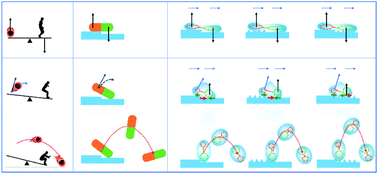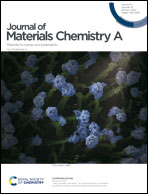Directed motion of an impinging water droplet—seesaw effect†
Abstract
Directing a liquid droplet after or upon impacting a solid is crucial in many biological, sustainable, environmental, and engineering applications. Despite significant progress in the translational motion of droplets on surfaces, a fundamental dynamic understanding of directional bouncing of an impinging droplet needs to be developed and improved. Here, we investigate the projectile motion of a droplet after impacting the superhydrophobic interfaces with various roughness gradients at room temperature. The results reveal that an initial oblique velocity and the reactive force generated in intrinsic gyration (seesaw effect) engender the preferential bouncing motion of a droplet towards a region with lower roughness. An arbitrary planar force is used to describe the basic mechanical model. New anti-gravity pendulum dynamics are deduced and demonstrated by tuning the model and adjusting the substrate gradient and the impact position. The direction of droplet transport is also flexibly adjusted by changing the structural parameter and the inclined angle of the substrate. This acts as a tri-directional rectifier and might be useful for creating a miniature musical fountain. This work advances the understanding of directed droplet transportation and also provides a promising approach to delicately control liquid motion by actuating a force model upon a designed interface.



 Please wait while we load your content...
Please wait while we load your content...